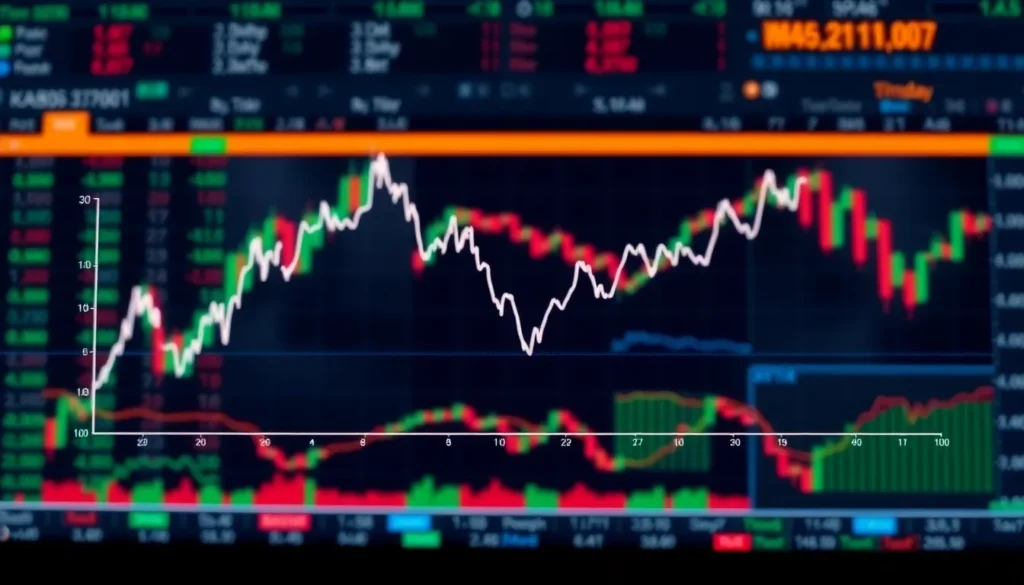The S&P 500’s 200-day moving average is like that wise old sage in the stock market—steady, reliable, and always ready to offer a glimpse into the future. Investors often turn to this powerful indicator to navigate the choppy waters of market trends. Whether you’re a seasoned trader or just dipping your toes into the financial pool, understanding this moving average can be the difference between a triumphant dive and a belly flop.
Picture it as your financial GPS, helping you avoid those pesky potholes of volatility. When the S&P 500 dances above this line, it’s like a green light for bullish sentiment. But when it dips below, it might just be time to put on those cautionary glasses. Join the journey to uncover how this simple yet effective tool can sharpen your investment strategy and keep your portfolio flourishing.
Table of Contents
ToggleUnderstanding the S&P 500 200 Day Moving Average
The S&P 500 200-day moving average serves as a critical barometer for assessing market trends. Investors interpret a position above this average as a bullish signal, indicating strong market momentum. They recognize that a decline below the 200-day moving average often suggests caution and potential downward movement.
This indicator calculates the average of the S&P 500 index over the last 200 trading days, providing a smoothed line that outlines overall performance. Traders can utilize this tool to identify longer-term trends, distinguishing regular fluctuations from significant shifts.
Fluctuations around the 200-day moving average may lead to different trading strategies. A strategy could involve buying when the index crosses above the average and selling when it dips below. This approach helps investors capture potential profit while managing risk effectively.
Data indicates that many investors find the 200-day moving average more reliable than shorter-term averages. Historical performance shows that it can signal trend reversals, making it a favored metric among technical analysts.
This moving average typically reacts slowly to market changes, minimizing noise and providing a clearer visualization of prevailing trends. When used in conjunction with other indicators, the S&P 500 200-day moving average can refine investment decisions, enhancing portfolio management outcomes.
Importance of the 200 Day Moving Average

The 200-day moving average serves as a vital component for investors assessing market trends. It provides clarity and insight into market behavior.
Trend Identification
Identifying trends in the S&P 500 becomes more straightforward with the 200-day moving average. Successful investors observe price movements in relation to this average. A sustained position above it indicates an uptrend, while consistent trading below suggests a downtrend. This indicator smooths out short-term fluctuations, enabling traders to focus on longer-term movements. Trends become more reliable when confirmed by additional indicators, reinforcing trading decisions based on the average. Investors often use this moving average to pinpoint potential entry and exit points, allowing them to capitalize on market shifts.
Market Sentiment Insights
Market sentiment insights emerge through the lens of the 200-day moving average. Investors gauge bullish or bearish attitudes based on the position of the S&P 500 relative to this average. A rise above signals optimism among traders, while a fall below can evoke caution. This tool reflects collective investor behavior, aiding in risk assessment. Utilizing this average alongside other data enhances market understanding. Furthermore, shifts in sentiment often precede significant price movements, making it an essential component for informed decision-making. Successful strategy development hinges on recognizing how the average interacts with overall market trends.
How to Calculate the 200 Day Moving Average
Calculating the 200-day moving average requires specific data points to ensure accuracy. Investors need the closing prices of the S&P 500 index for the last 200 trading days. This data serves as the foundation for identifying trends and market sentiment.
Data Required
Essential data points for this calculation include the daily closing prices of the S&P 500 index. Investors gather the prices from the previous 200 trading days. Accurate daily prices are vital, as they directly impact the calculated average. It helps to use reliable financial data sources or market platforms for consistency. After compiling the relevant data, investors can proceed with the calculation.
Calculation Method
Calculating the 200-day moving average involves a straightforward formula. First, sum the closing prices from the last 200 trading days. Next, divide this total by 200. The result provides the 200-day moving average. This process results in a smoothed line that reflects overall market performance. Frequent tracking of this average helps investors identify shifts in market trends effectively. Observing changes in relation to the average assists in making informed trading decisions.
Interpreting the S&P 500 200 Day Moving Average
Investors analyze the S&P 500 200-day moving average to gauge market trends effectively. A position above this average signifies robust bullish sentiment, indicating market strength. Conversely, a drop below this threshold evokes caution, often suggesting potential bearish conditions.
Observing price movements relative to the moving average aids in trend identification. An extended time above the 200-day moving average illustrates an uptrend, while fluctuating below often indicates a downtrend. Investors frequently utilize this metric to refine their strategies, buying when the index crosses above and selling when it dips below.
Analyzing historical performance enhances understanding of market behavior. Data reveals that the 200-day moving average often proves more reliable than shorter-term averages for identifying trend reversals. Regularly tracking this average equips investors to respond to market fluctuations proactively.
Understanding how to calculate the 200-day moving average is essential. This calculation requires summing the closing prices of the S&P 500 index over the last 200 trading days and dividing by 200. Utilizing accurate data sources ensures the reliability of this metric, reinforcing consistent market analysis.
Integrating the 200-day moving average with other indicators provides comprehensive market insights. Combining different tools facilitates more informed trading decisions. The rise above the average signals optimism in market sentiment, while falling below necessitates cautious consideration for potential downturns.
Trading Strategies Involving the 200 Day Moving Average
Several trading strategies incorporate the S&P 500’s 200-day moving average, helping investors make data-driven decisions. Buying occurs when the index crosses above this average. Selling typically happens when it dips below, signaling potential bearish trends. Many investors find this strategy effective due to its reliance on longer-term data.
Utilizing the 200-day moving average for trend identification is a common practice. When the index stays above this average for an extended period, it indicates a sustained uptrend. Conversely, consistent trading below the moving average suggests a downtrend in market sentiment. Noting these trends offers investors insights into market psychology.
A strategy involving crossovers can provide signals for trades. For instance, a bullish crossover (when a shorter-term average crosses above the 200-day) can prompt buying, while a bearish crossover (a shorter-term average crossing below) often leads to selling decisions. This method captures market momentum effectively.
Implementing the 200-day moving average alongside other indicators enhances trading strategies. Combining it with momentum indicators or relative strength index (RSI) often provides confirmation for trading signals. This multi-faceted approach assists investors in making more informed decisions.
Regular monitoring of the 200-day moving average helps identify important shifts. Observing when the index touches or bounces off this average can indicate potential entry or exit points. Tracking these movements allows investors to respond promptly to changes in market momentum.
Investors seeking a disciplined approach find value in setting stop-loss orders based on the 200-day moving average. This tactic helps protect against potential losses while maintaining exposure to upward trends. Effective risk management alongside this strategy can lead to more sustainable trading outcomes.
The S&P 500’s 200-day moving average serves as a vital indicator for investors aiming to navigate market fluctuations. By tracking this average, traders can gain insights into market sentiment and identify potential trend reversals. Utilizing strategies like crossovers and combining this moving average with other indicators can enhance decision-making and improve trading outcomes. Regularly monitoring the 200-day moving average allows investors to stay informed about market trends while managing risk effectively. Embracing this tool can lead to more disciplined and informed investment strategies.







